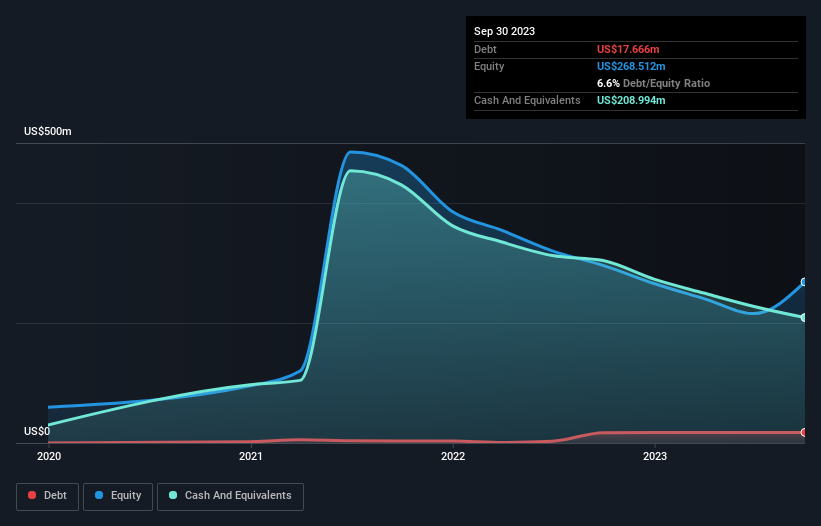
Howard Marks put it nicely when he said that, rather than worrying about share price volatility, 'The possibility of permanent loss is the risk I worry about... and every practical investor I know worries about.' So it might be obvious that you need to consider debt, when you think about how risky any given stock is, because too much debt can sink a company. As with many other companies Atai Life Sciences N.V. (NASDAQ:ATAI) makes use of debt. But is this debt a concern to shareholders?
When Is Debt A Problem?
Generally speaking, debt only becomes a real problem when a company can't easily pay it off, either by raising capital or with its own cash flow. In the worst case scenario, a company can go bankrupt if it cannot pay its creditors. However, a more common (but still painful) scenario is that it has to raise new equity capital at a low price, thus permanently diluting shareholders. Of course, plenty of companies use debt to fund growth, without any negative consequences. The first thing to do when considering how much debt a business uses is to look at its cash and debt together.
See our latest analysis for Atai Life Sciences
How Much Debt Does Atai Life Sciences Carry?
The chart below, which you can click on for greater detail, shows that Atai Life Sciences had US$17.7m in debt in September 2023; about the same as the year before. However, its balance sheet shows it holds US$209.0m in cash, so it actually has US$191.3m net cash.

A Look At Atai Life Sciences' Liabilities
Zooming in on the latest balance sheet data, we can see that Atai Life Sciences had liabilities of US$19.7m due within 12 months and liabilities of US$20.0m due beyond that. Offsetting this, it had US$209.0m in cash and US$1.50m in receivables that were due within 12 months. So it can boast US$170.8m more liquid assets than total liabilities.
This luscious liquidity implies that Atai Life Sciences' balance sheet is sturdy like a giant sequoia tree. With this in mind one could posit that its balance sheet means the company is able to handle some adversity. Simply put, the fact that Atai Life Sciences has more cash than debt is arguably a good indication that it can manage its debt safely. The balance sheet is clearly the area to focus on when you are analysing debt. But ultimately the future profitability of the business will decide if Atai Life Sciences can strengthen its balance sheet over time. So if you're focused on the future you can check out this free report showing analyst profit forecasts.
It seems likely shareholders hope that Atai Life Sciences can significantly advance the business plan before too long, because it doesn't have any significant revenue at the moment.
So How Risky Is Atai Life Sciences?
By their very nature companies that are losing money are more risky than those with a long history of profitability. And in the last year Atai Life Sciences had an earnings before interest and tax (EBIT) loss, truth be told. And over the same period it saw negative free cash outflow of US$93m and booked a US$67m accounting loss. But at least it has US$191.3m on the balance sheet to spend on growth, near-term. Overall, its balance sheet doesn't seem overly risky, at the moment, but we're always cautious until we see the positive free cash flow. When analysing debt levels, the balance sheet is the obvious place to start. But ultimately, every company can contain risks that exist outside of the balance sheet. These risks can be hard to spot. Every company has them, and we've spotted 3 warning signs for Atai Life Sciences (of which 1 is significant!) you should know about.
Of course, if you're the type of investor who prefers buying stocks without the burden of debt, then don't hesitate to discover our exclusive list of net cash growth stocks, today.
If you're looking to trade Atai Life Sciences, open an account with the lowest-cost platform trusted by professionals, Interactive Brokers.
With clients in over 200 countries and territories, and access to 160 markets, IBKR lets you trade stocks, options, futures, forex, bonds and funds from a single integrated account.
Enjoy no hidden fees, no account minimums, and FX conversion rates as low as 0.03%, far better than what most brokers offer.
Sponsored ContentNew: Manage All Your Stock Portfolios in One Place
We've created the ultimate portfolio companion for stock investors, and it's free.
• Connect an unlimited number of Portfolios and see your total in one currency
• Be alerted to new Warning Signs or Risks via email or mobile
• Track the Fair Value of your stocks
Have feedback on this article? Concerned about the content? Get in touch with us directly. Alternatively, email editorial-team (at) simplywallst.com.
This article by Simply Wall St is general in nature. We provide commentary based on historical data and analyst forecasts only using an unbiased methodology and our articles are not intended to be financial advice. It does not constitute a recommendation to buy or sell any stock, and does not take account of your objectives, or your financial situation. We aim to bring you long-term focused analysis driven by fundamental data. Note that our analysis may not factor in the latest price-sensitive company announcements or qualitative material. Simply Wall St has no position in any stocks mentioned.
About NasdaqGM:ATAI
Atai Life Sciences
A clinical-stage biopharmaceutical company, engages in the research, development, and commercialization of mental health treatments in the United States, Germany, and Canada.
Excellent balance sheet moderate.
Similar Companies
Market Insights
Community Narratives



